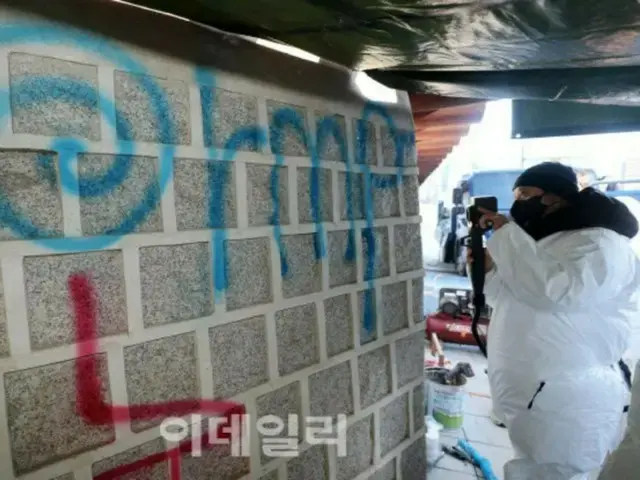I decided to make a claim. Korean media reported. The bill is expected to reach approximately 100 million won (approximately 11 million yen). On the other hand, the spray that the boy who did the graffiti used to commit the crime cost 2,000 won (approx.
20 yen), and Korean media are reporting the magnitude of the cost. On the 16th of last month, graffiti was found spray-painted on a wall near the west gate and Yeongchumun of Gyeongbokgung Palace. There is a sign on the wall that says ``Free Movies.''
It contained text and the address of an illegal video sharing site. Police then detained a male and female teenager on suspicion of violating the Cultural Properties Protection Act. Police investigated the man and woman receiving messages from an unknown person.
He stated that he was approached via the social networking app Telegram and offered to pay him if he did some graffiti, which led him to commit the crime. According to Korean media, the two received a total of 100,000 won before committing the crime.
. After committing the crime, he was supposed to receive several million won, but he was unable to contact the person who had suggested the graffiti. The arrest warrant was later dismissed because the two were minors.
Ta. Another graffiti was discovered at Gyeongbokgung Palace on the 17th, the day after this graffiti was discovered. While the Cultural Heritage Agency was conducting erasure and restoration work at the site, a similar incident occurred again near the work site.
There was a lot of surprise. The names of singers and album names were spray-painted on the walls of Yeongjumun Gate in Gyeongbokgung Palace. On the 18th, a man in his 20s turned himself in to the police and was arrested on suspicion of violating the Cultural Properties Protection Act.
Ta. The law prohibits the act of writing or drawing on designated cultural properties such as national treasures, treasures, historic sites, and places of scenic beauty. Violations are punishable by imprisonment for more than three years. Also, damage
It stipulates that the costs incurred in restoring damaged cultural properties to their current state may be claimed. Gyeongbokgung Palace was built in 1395 by Lee Seong-gye, the first king of the Joseon Dynasty.
The royal palace of the dynasty, consisting of five palaces. It is the largest of the five royal palaces in Seoul, and is a popular tourist spot with the National Folk Museum on the premises.
Immediately after the incident was discovered, restoration work has been underway by experts from the National Palace Museum and the National Research Institute for Cultural Properties, but the
On the day of the work, the fence that had been covered was removed and the outer wall was opened to the public. However, at this point, the condition is about 80% of the former, and the second stage of maintenance will be carried out while monitoring the surface of the stone and the state of color changes.
The work to dispose of the remains is proceeding. However, it is said that it is not possible to make it 100% former. According to the Korean newspaper JoongAng Ilbo, the National Institute for Cultural Properties Conservation Science, which spearheaded the work at the site, said:
Lee Tae-jeong, curator and researcher at the center, told the newspaper, ``Pigment components such as trilead tetroxide have seeped into the gaps between the particles that make up the walls' stones. The fence itself
There is no choice but to rebuild it. You have to do it only to the extent that you don't feel any discomfort. I can't help it.'' According to Yonhap News, the work was carried out for a total of eight days, and a total of 23
Four people were deployed, an average of 29.3 people per day. The cost was 9.46 million won for rental of steam cleaning machines, laser cleaning machines, etc., and 12.07 million won for dust-proof clothes, gloves, work shoes, etc. required for work.
The total cost was 21.53 million won. Yonhap said, ``The cost is expected to increase significantly if the labor costs of the experts involved in the work are included.''
The Cultural Heritage Agency plans to demand compensation from the culprit. Korean media News 1 said, ``If actually requested, 2
This is the first case since the revision of the Cultural Properties Protection Law in 2020." This includes not only the man in his 20s who is suspected of doing the second graffiti, but also the teenage boy who is suspected of doing the first graffiti.
If they are unable to pay, they are expected to file a claim with their parents.
2024/01/17 11:49 KST
Copyrights(C)wowkorea.jp 5

